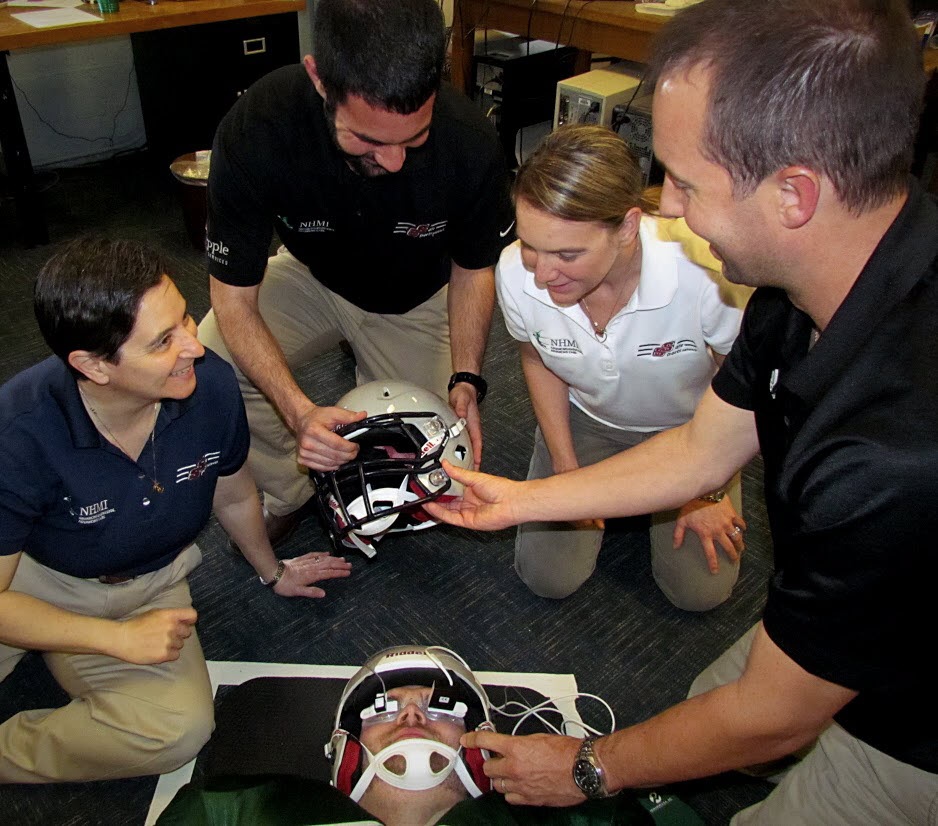|

Cohen MR, Silva KJ, Decoster LC, Tucker WS*, Hollingworth AT, Swartz EE†: New Hampshire Musculoskeletal Institute, Manchester, NH, *University of Central Arkansas, Conway, AR, †University of New Hampshire, Durham, NH.
Context: Current recommendations for emergency management of cervical injuries in American football suggest that helmet removal is sometimes necessary. To remove the helmet, the chinstrap must be removed. The current recommendation is to cut the chinstrap rather than unsnap it, but no data exists to support this. Some experts suggest helmet removal may be facilitated by first removing the facemask. Therefore, chinstrap removal in both scenarios should be investigated.
Objective: Compare head motion during chinstrap removal by cutting and unsnapping, with and without the facemask in place.
Design: Repeated measures.
Setting: Controlled laboratory.
Participants: Pilot data indicated a sample size of 15 pairs was needed to achieve a power of 0.80. Thirty-four certified athletic trainers volunteered (males=17; age=29.35±8.57yrs, height=180.19±5.51cm, weight=85.33±14.88kg, experience=6.91±8.58years), (females=17; age=26.18±3.11years, height=163.64±6.83cm, weight=74.63±16.48kg, experience=2.80±2.42years).
Interventions: A properly-fitted Riddell 360 helmet and Power CPX shoulder pads were worn by a healthy, supine, male model. Each participant pair cut off or unsnapped the chinstrap with and without the facemask in place, in random order, for 2 trials each. While one partner performed the removal, the other stabilized the head. A new pair of scissors was used for each group. A 2-dimensional inclinometer mounted onto the model’s goggles captured head motion (transverse and sagittal planes).
Main Outcome Measures: The independent variables were facemask (on and off) and chinstrap removal technique (cut and unsnap). The dependent variables were the integrated head motion in the transverse and sagittal planes. For each dependent variable, a two-way analysis of variance was performed (p<0.05).
Results: There was an interaction for the transverse plane (F1,16=43.059; p<0.001). Unsnapping the chinstrap with the facemask on (6.83±3.03°) created significantly less integrated motion than cutting with the facemask on (26.49±12.69°) and cutting with the facemask off (15.02±6.56°). Unsnapping with the facemask off (9.4±3.9°) and cutting with the facemask off created less motion than cutting with the facemask on. For the transverse plane, main effects existed for facemask (F1,16=9.074; p=0.008) and chinstrap (F1,16=29.522; p<0.001). The facemask off (12.21±6.03º) was less than the facemask on (16.66±13.49º).Unsnapping (8.12±3.68º) was less than cutting (20.76±11.52º). There was an interaction in the sagittal plane (F1,16=11.041; p=0.004). Unsnapping with the facemask on (6.58±2.66°) and unsnapping with the facemask off (12.34±8.61°) created less motion than cutting with the facemask on (32.27°±9.64) and cutting with the facemask off (26.66±12.97°). There was a main effect for chinstrap (F1,16=58.204; p<0.001). There was less motion with unsnapping the chinstrap (9.45±6.92º) compared to cutting the chinstrap (29.46±11.61º).
Conclusions: Although a motion threshold for injury exacerbation is unknown, these results suggest unsnapping the chinstrap generates less head motion than cutting, and chinstrap removal with facemask off generates less head motion than with facemask on. This first finding is contrary to current recommendations.
|
|










